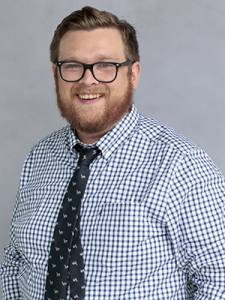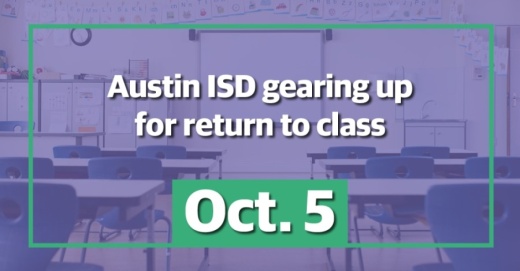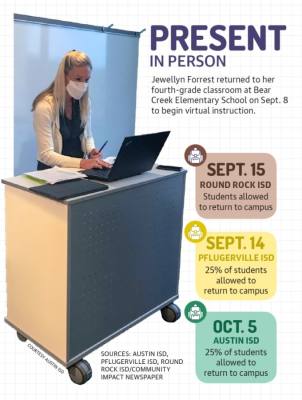New AISD Superintendent Stephanie Elizalde told Community Impact Newspaper that the district has been nimble this summer in creating back-to-school plans and has pivoted as needed. This included delaying the start of the school year by three weeks to help with preparation.
“There’s no perfect plan [for reopening during COVID-19], but there are ways to improve, and a little bit more time did give us opportunities to do a few things,” she said.
During that time, Elizalde said teachers were directed to focus on building relationships with their new students and helping students get connected over the first few weeks of class, and to ease into offering an online curriculum that will be used through the semester.
However, come Oct. 5, AISD teachers and students will have to transition again, as some students will return to their physical classrooms for the first time since early March.
IN-PERSON INSTRUCTION AT A GLANCE
In September, AISD teachers provided instruction 100% virtually.
A typical day is a mix of classes in which students and the teacher are all online at once, along with periods in which students sign off of the virtual conference, working on their own with teachers available online.
Cristina Coro, Crockett High School art teacher, said that when some students return to campus in October, instruction will not change much.
“Whether you’re physically in the classroom or whether you’re at home, the lessons will be the same,” Elizalde said. “I don’t want kids who are face-to-face to have advantages over kids that are in a virtual setting.”
In elementary schools, the district plans to have students who choose the in-person option in the classroom with their teacher. Those students will continue to submit assignments and follow the lessons through their devices in school.
Coro said when students return, she will be teaching from her classroom while a small number of students sit at socially distanced desks. However, the chances a student is in a classroom with a teacher they actually have for instruction is slim, Crockett principal Kori Crawford said.
The classroom will act as a homeroom, while teachers continue to teach lessons through the virtual platform to their students. Students in the classroom will simultaneously be plugged into their devices, participating in their classes individually.
The goal, Crawford said, is to reduce the spread of COVID-19 by cutting down on how much students move around campus.
“I haven’t had any parent push back at all,” Crawford said. “I think they understand that it’s for the safety of our staff and students. Unfortunately, this is the best model we have.”
PARENTS FACE TOUGH DECISIONS
From Sept. 10-21, AISD parents were asked in a survey to select if they would like their students to learn on campus or to continue from home.
AISD parent Anya Wiley said she and her husband immediately knew they would keep their two children home even after students are allowed back.
Their daughter, Aniya, 8, is a third grader at Bryker Woods Elementary School. She has a respiratory issue called reactive airway disease and is at a greater health risk if she were to contract the virus. Their son, Jeremiah, 16, is a junior at Austin High School. Wiley said the risk of him being in the same building with possibly 1,000 other students is too great.
“I want them to go back to the classroom, by all means, but not now. It’s too risky,” Wiley said.
That decision has varied for parents across the district. Based on an AISD survey conducted over the summer, an estimated 32% of parents are interested in sending their children to school once an in-person option is made available.
Elizalde said if the number of in-person requests surpasses a school’s capacity to hold safe instruction, the district will have to make decisions on who will be allowed on campus.
“We’re going to have to create a prioritization, which isn’t going to make people happy, but there are no other options except to prioritize if you’re really talking about equity,” she said. “Students with special needs would have to have priority, then I think you have to look at students that have challenges economically.”
Meanwhile, many of AISD’s neighboring school districts returned students to campuses in September.
Mariah Price, a parent of a Round Rock ISD second grader, said her family made the decision to return her daughter to school shortly after the district’s online-only academic year began. Both Price and her husband are essential workers who have to leave the house, and Price is continuing her education on top of that. In order to keep a parent home to help their daughter with school, the RRISD parent said she and her husband have had to change their work schedules.
“It’s definitely more difficult for those parents who don’t have the luxury of working from home,” Price said.
When the school year began as online only, Price said her daughter was receiving only approximately two hours of actual instruction per day. Price’s daughter and the rest of the class would log for a one-hour class at 8:30 in the morning and then again in the afternoon.
“That is pretty much it. We do whatever instruction she’s been given until it’s over,” Price said. “[My daughter] thrives on structure and routines, and that’s what [being in] the school gives. ... She’s not in the proper learning environment.”
Approximately 11,000 students returned to RRISD classrooms after the district opened the doors to campuses Sept. 15.
Similarly, Pflugerville ISD began welcoming students back on a limited basis beginning Sept. 14. PfISD opened with a 25% capacity at its campuses, with priority given to students without internet access and children of PfISD staff who work on campus, according to the district’s website.
That 25% cap can only remain in place through mid-October, according to state law. At that point, PfISD will not be able to limit capacity at its elementary and middle schools, and the district’s high schools will have to operate under a 40% hybrid online and in-person model. IS OCTOBER TOO SOON? As classes remain virtual heading into Oct. 5, AISD is encouraging staff to teach online lessons from their classrooms.
Those teachers who are not at a heightened health risk will be asked to return to campus Oct. 5, Elizalde said.
“Overwhelmingly, teachers want to be with their kids, and they want to do it in a safe way,” she said.
Under current Texas Education Agency regulations, districts could lose state funding if they do not offer parents the option for in-person education after the first eight weeks of school. As a result, AISD will begin offering in-person classes in October and will phase more students into the classroom over time.
Despite this, Education Austin—the union that represents over 3,000 AISD staff members—has called for AISD to not offer any in-person instruction this semester. Union President Ken Zarifis said the best way to keep teachers and students safe during the pandemic is by keeping them home.
“Our teachers and staff are very nervous about coming back to a physical space, and rightly so,” Zarifis said. “We know that where there are more people gathering, there’s more likelihood of COVID-19 spreading.”
Confirmed COVID-19 cases were reported in Eanes and Leander ISDs within a week of students returning to class in early September. AISD has also had positive COVID-19 results among its staff while instruction was virtual.
Zarifis said Education Austin has been happy with how Elizalde has addressed the coronavirus pandemic so far, including delaying the start of school. Zarifis said he hopes the superintendent delays in-person learning further.
“What I’d like to see leadership at districts [across the state] do is say, ‘No, [the TEA is] not going to dictate to us what we do,’” he said.
If students do return as scheduled, Northeast principal Sterlin McGruder said his school will be prepared. Some of his teachers have already returned to campus, and he said they are beginning to feel comfortable with their routine.
Other staff members are still worried about returning. Northeast High’s attendance zone includes families from the 78753 ZIP code, which as of Sept. 14 had the second most COVID-19 cases reported in Travis County, according to Austin Public Health data. That has created some unrest among the staff, McGruder said.
“There’s always a risk of coming back and catching COVID-19,” McGruder said.
McGruder said his biggest concern is that people, historically, have been conditioned to come to class or go to work when they’re sick. With COVID-19, that mentality changed on a dime, but some still have not been able to adjust.
“This is not the time to go to work sick,” he said. “We don’t want to let our teammates down, and we care about our family, so I think that everybody will try to make the best decisions.”
Additional reporting by Iain Oldman







